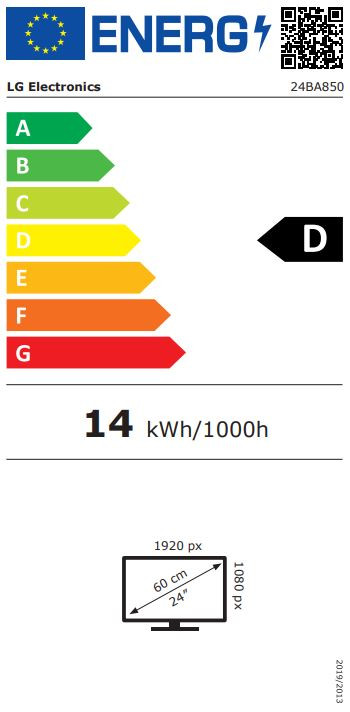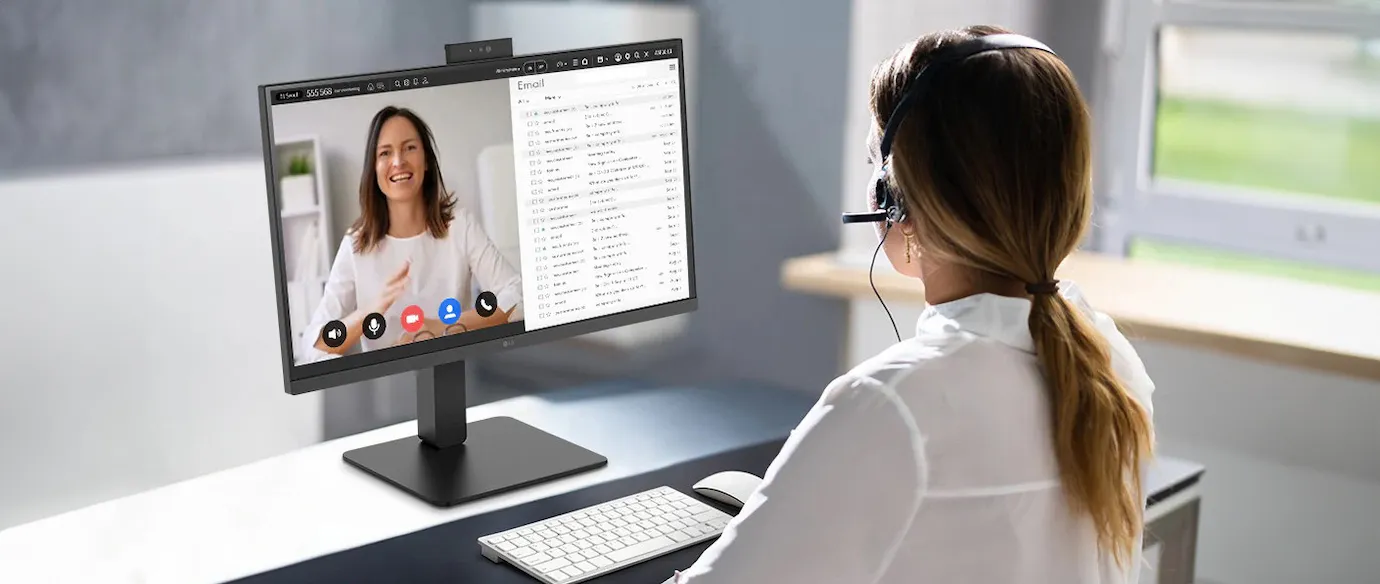







































£312.40*
- Resolution 1920 x 1080 Full HD
- Diagonal 24"
- Panel type IPS
- Refresh Rate 100Hz



Product information
The LG 24BA850-B monitor combines powerful technology and ergonomic design in a compact format. With its 24-inch Full HD IPS display,integrated webcam, microphone and speakers it is the ideal choice for productive and modern working environments that prioritise efficiency and comfort.
The technical data at a glance:
- Screen size: 24" Full HD (1920x1080) IPS display, anti-glare
- Refresh rate: 100Hz
- Integrated components: Full HD webcam, microphone, speakers
- Ports: USB Type-C™ (PD 90W), RJ45 and other connections
- Ergonomics: tilt, swivel, pivot and height-adjustable stand
- Comfort features: Reader Mode & Flicker Safe
- Certifications: EPEAT & Energy Star
Brilliant colours and a clear view from every angle
The LG 24BA850-B impresses with its 24-inch Full HD IPS display, which offers vivid colours and crystal-clear imagesfrom almost every angle. IPS technology ensures uniform and accurate colour reproduction, ideal for office collaboration or sharing content at meetings. The anti-glare coating reduces distracting reflections, improving visibility even in difficult lighting conditions.
Maximum productivity thanks to 100Hz and USB Type-C™
With a refresh rate of 100Hz, the monitor enables smooth displays without delays or motion blur. This improves the user experience and increases productivity when working with multiple applications. The USB Type-C™ port not only provides a quick and easy connection to devices, but also supports laptop charging at up to 90W - all via a single cable, which is included in the scope of delivery.
Integrated webcam, microphone and speakers - ready for virtual meetings
The LG 24BA850-B is perfectly equipped for virtual meetings or video calls: The integrated Full HD webcam, microphone and speakers enable professional communication without additional effort. This all-in-one solution saves space on the desk and makes it easier to participate in online conferences or presentations.

Ergonomic design for maximum comfort
The monitor supports various ergonomic settings to ensure maximum comfort. With the height-adjustable, swivelling and tilting stand, the monitor can be individually adjusted so that a comfortable working position can be found for every user. Particularly practical for long working days, it supports a comfortable posture and facilitates communication with colleagues.
Eye-friendly features for longer working
Thanks to the Reader Mode and Flicker Safe technology, the LG 24BA850-B offers maximum visual comfort, even after hours of use. The Reader Mode reduces blue light exposure and adjusts the colour temperature to make reading text more comfortable. The Flicker Safe function minimises invisible flickering, which relieves eye strain and contributes to a more comfortable working environment.
The LG 24BA850-B monitor combines state-of-the-art technology, user-friendly design and versatile connectivity, making it the ideal solution for professional, productive and comfortable working environments.
Technical data
| Name | LG 24BA850-B 24" Monitor |
|---|---|
| Article number | 1000033166 |
| GTIN/EAN | 8806096207109 |
| Manufacturer SKU | 24BA850-B.AEU |
| EPREL ID | 2,010,425 , 2010425 |
| Model name | 24BA850-B |
| Brand | LG |
| Product Type | Monitor |
| Panel type | IPS |
| Resolution | 1920 x 1080 Full HD |
| Diagonal | 24" |
| Aspect Ratio | 16:9 |
| Viewing angle - Horizontal | 178° |
| Viewing angle - Vertical | 178° |
| Contrast Ratio | 1,300 :1 |
| Max. Brightness | 250 cd/m² |
| Response time | 5ms |
| Refresh Rate | 100Hz |
| Support - VESA | 100 x 100 |
| Inputs | 1x Displayport , 1x Ethernet , 1x HDMI , 1x USB-A , 1x USB-C |
| Outputs | 1x 3,5mm Jack , 1x Displayport |
| Product width | 53.96 cm |
| Product height | 32.3 cm |
| Product depth | 5 cm |
| Weight | 6.7 kg |
| Colour | Black |
| EEK Spectrum | A to G |
| Energy efficency class | D |
| Condition | New |
| Warranty | 36 Month |
| Warranty type | Swap service Service and support information |
Product safety
| Person responsible for the EU |
|---|
| LG Electronics Deutschland GmbH |
| Alfred-Herrhausen-Allee 3-5 |
| 65760 Eschborn |
| Germany |
| info@lge.de |



